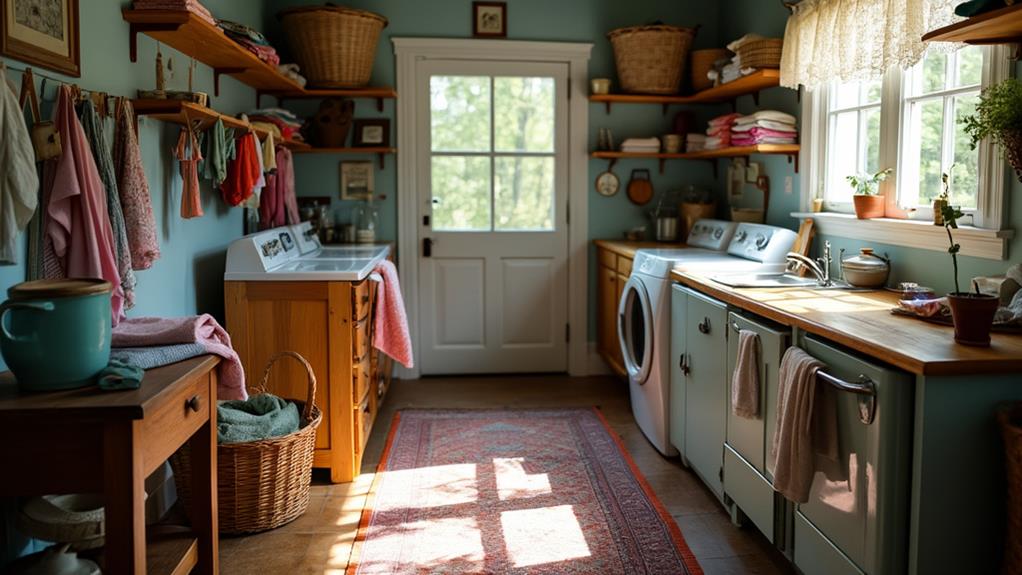To master your textiles, start by following the care labels, which guide washing and ironing temperatures essential for preserving fabric integrity. Avoid overloading your washing machine for better cleaning, and prefer air drying to reduce shrinkage. Spot cleaning with natural solutions like vinegar and baking soda can be effective. Use fabric protector sprays to prevent stains, and consider professional cleaning for delicate fabrics. Regular maintenance tasks, like vacuuming upholstery and shaking clothes, help maintain shape and freshness. For pet owners, choose durable fabrics and use protective finishes to simplify maintenance. There's more to uncover in the world of fabric care.
Table of Contents
ToggleImportance of Proper Fabric Care
When you take proper care of your fabrics, you're not just maintaining their appearance but also extending their lifespan. Each fabric type has unique maintenance requirements, ensuring they remain vibrant and durable.
Regular attention to textiles reduces wear, promoting sustainability by decreasing the need for replacements. By understanding specific care instructions, you enhance both the aesthetic and emotional value of your garments and home textiles.
Establishing a fabric care schedule can streamline maintenance, addressing tasks like washing, drying, and storage systematically. Involving household members distributes the responsibility, making fabric care a shared effort.
Organizing fabric care products for easy access simplifies your cleaning process, ensuring you maintain the beauty and functionality of your fabrics for years to come.
Understanding Care Label Symbols
As you focus on maintaining your fabrics, understanding care label symbols becomes a key aspect of preserving their quality and longevity.
These labels contain critical information, guiding you through the appropriate washing, drying, ironing, and dry cleaning methods for each textile. Washing symbols often include dots, indicating water temperature: one dot signifies cold, two for warm, and three for hot.
Ironing symbols also use dots to suggest temperature settings. A hand wash symbol implies delicate handling is necessary to prevent shrinkage.
For drying, symbols will tell you whether air drying or tumble drying is appropriate. Additionally, dry cleaning symbols specify which chemicals are safe to use.
General Fabric Care Guidelines
To guarantee your fabrics last and maintain their beauty, it's vital to follow general fabric care guidelines.
Start by checking care labels, which offer significant information on washing, drying, and ironing methods. Avoid overloading your washing machine, as it guarantees thorough cleaning and prevents damage.
Choose air drying over machine drying whenever possible to preserve fabric integrity and avoid shrinkage. Delicate textiles benefit from gentle cycles and mesh bags during machine washes.
Regular inspections of your fabrics can help identify early signs of wear or damage, allowing for prompt repairs. For items like curtains, washing every 3 to 6 months keeps them fresh and dust-free.
Techniques for Daily Maintenance
Understanding general fabric care guidelines sets a solid foundation for maintaining your textiles, but incorporating effective daily maintenance techniques is equally important.
Regularly brushing or vacuuming upholstery prevents dirt buildup, preserving the fabric's appearance and longevity.
Shaking clothes before and after wear helps maintain their shape, reducing the need for frequent washing.
Airing out fabrics in well-ventilated spaces refreshes them, minimizing odors and prolonging freshness.
Using steam from a bathroom to reduce wrinkles in clothing is an efficient alternative to ironing.
Fabric refresher sprays can keep items smelling fresh between washes, enhancing their appeal.
These techniques are essential for sustaining the quality and appearance of your textiles, ensuring they remain in excellent condition with minimal effort.
Spot Cleaning and Natural Solutions
Spot cleaning is an essential aspect of fabric care that can save you from dealing with permanent stains.
When tackling stains, always blot instead of rubbing to prevent deepening the mark. Water might be a common cleaning agent, but it's not suitable for all stains. Cornstarch or talcum powder can absorb oil-based stains effectively.
For stubborn stains, a mild dish soap mixed with water can work wonders. Always test cleaning solutions on inconspicuous areas to prevent damage.
Natural alternatives like vinegar can act as fabric softeners, and lemon juice serves as a stain remover and brightener for whites.
Baking soda is an excellent deodorizer, while essential oils can add pleasant scents and antibacterial properties to your fabrics.
Benefits of Professional Cleaning
While spot cleaning and natural solutions are handy for everyday mishaps, certain situations call for the expertise of professional cleaning services.
These experts use specialized equipment that penetrates deep into fabric fibers, ensuring a thorough clean that home methods can't achieve. They handle delicate or bulky items, offering tailored care that rejuvenates worn fabrics.
Professional services also extend the lifespan of your textiles by using advanced techniques and safe chemicals, reducing the risk of damage. Regular professional cleaning helps maintain the integrity of your fabrics, keeping them looking vibrant and new.
Additionally, consulting with professionals can provide you with specific care recommendations for unique fabrics, ensuring that each textile receives the attention it deserves for ideal preservation.
Protective Treatments for Fabrics
When it comes to preserving the quality and appearance of your fabrics, protective treatments play an indispensable role.
Fabric protector sprays form an invisible barrier, repelling spills and stains, which is essential for maintaining your textiles' pristine condition.
UV protectants are critical for fabrics exposed to sunlight, as they prevent fading and deterioration, guaranteeing longevity.
In humid environments, applying mildew resistance treatments can thwart mold growth, safeguarding your items.
Reinforced fabric treatments enhance durability, especially for high-use items like furniture and outdoor gear.
Professional application of these treatments offers long-lasting benefits, as experts utilize specialized equipment and techniques to guarantee even coverage.
Fabric Care Tips for Pet Owners
For pet owners, maintaining the quality of your fabrics can be challenging but not impossible with the right strategies.
Start by selecting durable, tightly woven materials that can withstand wear from pets. Look for fabrics with protective finishes to repel hair and stains.
Regularly groom your pets to minimize shedding and prevent fabric contamination. Use enzyme cleaners for effective stain and odor removal, ensuring no damage to textiles.
Implement slipcovers or throws for easy cleaning and added protection of furniture.
Pet-friendly fabrics resist common stains and odors, making them ideal for households with animals. Stain-resistant technologies enhance fabric longevity, simplifying maintenance.
Moisture-wicking fabrics improve comfort and hygiene, particularly in active environments.
These strategies effectively manage pet-related fabric challenges.


